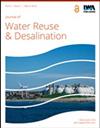基于微流的降膜蒸发器处理含盐废水竖管内传热系数分布及实验验证
IF 2.3
Q2 Environmental Science
引用次数: 2
摘要
利用热脱盐技术,尤其是降膜蒸发器处理含盐废水,仍然是重要的解决方案之一。为了提高降膜蒸发器的性能,采用VOF模型对含盐废水在垂直管中的气液两相流动特性进行了数值研究。结果表明,在相同的操作条件下,含盐废水的入口速度增加,导致液膜增厚,平均对流传热系数增加。工作液入口温度的升高降低了温差,导致平均对流传热系数的降低。此外,随着工作液入口浓度的增加,膜流速和平均对流传热系数先减小后略有增加。实验结果验证了数值模拟的准确性,平均误差为9.27%。本文章由计算机程序翻译,如有差异,请以英文原文为准。
Distribution of heat transfer coefficient in the vertical tube of falling film evaporator treating saline wastewater based on micro flow and experimental verification
It is still one of the significant solutions to treat saline wastewater with thermal desalination technology, especially falling film evaporators. To improve the performance of the falling film evaporator, a numerical study on the gas–liquid two-phase flow characteristics of saline wastewater in the vertical pipe was conducted using the VOF model. The results showed that the inlet velocity of the saline wastewater increased under the same operating conditions, resulting in the thickening of the liquid film and the increase of the average convective heat transfer coefficient. Increasing the inlet temperature of the working liquid reduced the temperature difference, which led to a decrease of the average convective heat transfer coefficient. In addition, as the inlet concentration of the working liquid increased, the film flow rate and the average convective heat transfer coefficient first decreased and then increased slightly. The experimental results verified the accuracy of the numerical simulation, and the average error was 9.27%.
求助全文
通过发布文献求助,成功后即可免费获取论文全文。
去求助
来源期刊

Journal of Water Reuse and Desalination
ENGINEERING, ENVIRONMENTAL-WATER RESOURCES
CiteScore
4.30
自引率
0.00%
发文量
23
审稿时长
16 weeks
期刊介绍:
Journal of Water Reuse and Desalination publishes refereed review articles, theoretical and experimental research papers, new findings and issues of unplanned and planned reuse. The journal welcomes contributions from developing and developed countries.
 求助内容:
求助内容: 应助结果提醒方式:
应助结果提醒方式:


